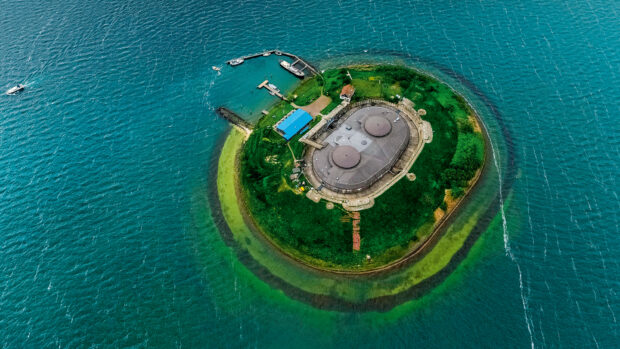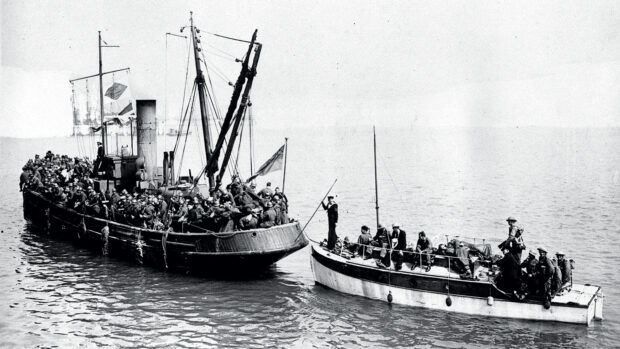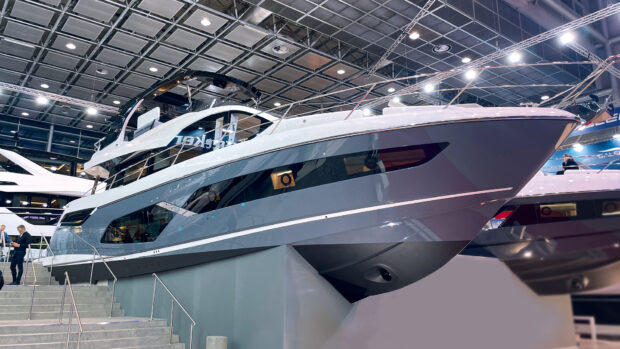In this boating knowledge article Jonathon Savill talks through all the options for boat decking from ethical teak to teak alternatives
Before the advent of fibreglass, boat decking was pieced together from multiple wooden planks to form a structural watertight covering. These days most boats are built using a much simpler one-piece moulded non-slip GRP deck and superstructure that is bonded onto the open hull like the lid of a giant sandwich box.
This does much the same job as a traditional wooden deck but lacks many of the practical and aesthetic properties that boat owners value such as grip, warmth, comfort underfoot and, of course, style.
So even though it’s not strictly necessary, many boat owners choose to fit some form of additional decking material, either as a new build option or an aftermarket upgrade. This will spend most of its time either being baked by the sun, soaked in water or trodden on by multiple feet, so UV resistance, durability and sustainability are also important considerations.

Nothing beats the look and feel of a good teak deck due to the wood’s natural properties but concerns over sustainability and supply are growing
What are the different types of boat decking?
The main choices are natural wood, chemically modified wood, synthetic teak, cork or EVA foam decking.
What wood is suitable for boat decking?
Most woods fall into two categories: hardwood and softwood. Hardwood comes from deciduous trees that lose their leaves annually. They grow slower, the grain is tighter and the timber denser and stronger. That said, not all hardwoods are suitable for decking as they are prone to swelling, warping and splitting from constant exposure to water and sun.
The best hardwoods for decking are teak, iroko and sapele as they are resistant to water absorption and contain natural oils that prevent rot and insect damage. Softwood comes from evergreen conifers such as pine and larch. They grow quicker so the timber is softer and looser grained but can still be used for decking if treated.

A natural teak decking like the one fitted to this Riva 110 Dolce Vita is a thing of beauty but good quality plantation teak requires regular maintenance
Is teak wood the best choice?
Teak trees are native to Malaysia, Thailand, Myanmar (formerly Burma), India and Indonesia. They can grow as tall as 130ft and have a diameter of up to 5ft. These trees are known as ‘old growth Burmese teak’ and take more than 100 years to grow.
When it was in plentiful supply, teak offered a natural, aesthetic, tight grained, durable material which machined well and aged beautifully. High levels of silica and oil make it extremely durable and weather resistant, while the tight grain creates high tensile strength and helps withstand rot, fungi and mildew. This type of old teak is now all but impossible to source due to trade restrictions and government sanctions.
Why is old teak wood so hard to find?
Burmese teak is not listed in either the CITES list of endangered plants or the IUCN red list of threatened species (unlike mahogany, rosewood and African blackwood, which are). However, the Forest Stewardship Council, which promotes responsible management of the world’s forests, refuses to certify any forests in Myanmar due to uncontrolled deforestation and the risk of illegal logging.

Spirit Yachts build all their craft, including this electric foiling P35, from wood and epoxy resin, using a variety of different FSC certified timbers
In 2013 this became even more problematic when the EU Timber Regulations (EUTR) came into force, prohibiting the sale of illegally harvested timber in Europe. Despite a common understanding among member states that it was impossible for Myanmar to comply with the EUTR, a certain amount of teak continued to find its way into the EU, until a combination of high-profile prosecutions and trade sanctions against the military junta in Myanmar, effectively put an end to it.
Post Brexit, the UK has introduced its own Timber Regulations, preventing UK timber suppliers from sourcing Burmese teak via third-party EU importers.
The teak imported before Brexit didn’t just evaporate and a few merchants we spoke to still have limited supplies available for ‘special projects’. Moody Decking Services has some Myanmar Teak (purchased prior to Brexit and Myanmar sanctions) and Indian Teak (UKTR approved and FSC controlled material), as well as Costa Rican plantation teak.

A managed teak plantation still takes 25 years for the trees to grow
What is plantation teak wood?
As the name suggests, it is teak that has been planted and grown specifically for harvesting rather than taken from virgin forests. There are currently plantations in Brazil, Central America, India and Africa.
The good news is that teak is one of the faster growing tropical hardwoods, growing at a rate of about half an inch per day. Even so, it takes around 25 years for a tree to be ready for harvesting. The disadvantage is that a plantation takes up more land and requires more water than a natural forest.
The trunk is about half the size of teak and the grain is not as tight so the wood is softer. Young plantation trees also have a larger percentage of lower branches, which causes ‘pin knots’ in the grain.
Despite this, Gordon Lamb, Sales Director of Robbins, Britain’s leading marine timber merchant, says that plantation teak is gaining traction in the marine industry. Wattsons also offer FSC-certified teak imported from Java and India. Between them, these two companies supply teak to Sunseeker, Princess and Fairline Yachts.

Electric boat manufacturer X Shore uses cork decking on all its craft. It is lighter, softer underfoot, more sustainable and cheaper to buy and fit than teak
What other wood can you use for boat decking?
Spirit Yachts, which build entire boats from wood, stopped using Burmese teak in 2018 due to concerns over sustainability. They experimented with several timbers for decking but currently use douglas fir as it is knot-free with a tight grain and resistant to rot and insects.
Wim Cnoops of Star Yachts says that larch is also a viable decking option. It too is available in long lengths but due to the number of knots, it takes a lot of logs to find enough knot-free planking for an entire deck.

Treated softwood is one of several alternatives
What is chemically modified timber?
Modified wood is natural timber that has undergone a chemical, thermal or physical process to enhance key properties such as durability and dimensional stability. This usually involves treating fast-growing softwood, such as pine, that reaches maturity at around 30 years, so that it behaves like hardwood. The end result is cheap, sustainable and long lasting.
Who makes this chemically modified timber?
Welsh company Lignia won a DAME Award in 2019 for its resin-infused timber. Spirit Yachts used it for the deck of three of their yachts. Unfortunately, Lignia ceased trading in 2022 and there are no current plans to restart manufacture.
Accoya is another form of chemically modified timber made by Accsys. Richard Clipson explains: “We put the raw timber through an acetylation process using acetic acid”.

Cork is also gaining traction
Wood’s main drawbacks, such as low-dimensional stability and biological vulnerability, stem from the presence of hydroxyls in its cell walls, many of which attract water. By replacing these hydroxyls with acetyls, which don’t attract water, the timber becomes more biologically stable and resistant to damp.
Accoya carries a guarantee of 50 years above ground and 25 years below ground or in freshwater. There is no fixed guarantee for salt water but that’s because of the risk of wood-boring beetles rather than the presence of salt.
Robbins Timber recently supplied Accoya to replace the decking on the 1843 steamship SS Great Britain. Gordon Lamb says: “It was a huge job. We used more than 12,500 linear metres”.
It also has a new product called Accoya Color, which is coloured grey through to the core, making it long lasting and low maintenance, without the need for coatings or treatments. It hopes this will prove even more popular in the marine market.

Although Sunseeker offers plantation-grown teak as an option on all its craft, the Superhawk 55 was originally designed with Flexiteek in mind
What is synthetic teak?
Synthetic teak looks like natural teak but is manufactured from plastic composites. The advantage is that it is hard wearing, UV resistant and largely maintenance free. The disadvantage is that it tends to be hotter underfoot than natural wood.
You can choose from a large pallet of colours and styles, including a growing number of finishes that are no longer intended to look like real wood but offer a lighter, more modern alternative.
Manufacturers of synthetic teak include Flexiteek, Permateek, Evo Decking, Tek-Dek and Esthec. Flexiteek launched its first product in 2000 and many of its original decks are still going strong today. It launched its latest 2G decking in 2014, which comes in a wider choice of colours and caulking and has more natural grain and colour variation. EVO Decking is another UK-based manufacturer of synthetic teak which launched its new offering at the Southampton Boat Show 2023. It claims that its product is indistinguishable from teak in terms of aesthetics and colour variation. It also has enhanced UV stabilisers and fungal inhibitors.
Most synthetic teaks are recyclable and made using phthalate-free plasticisers to reduce their environmental impact. Expect to pay around £400 per square metre for a fully fitted synthetic teak deck.

Not all modern decking is designed to imitate teak
What is EVA foam decking?
As the name suggests, EVA decking is a slightly spongy but durable foam-based decking material that is soft, grippy, cool underfoot and available in a wide range of different colours. It is made from ethylene vinyl acetate and has a closed-cell structure that provides resistance to water and moisture.
James Gant of Sea-Dek provides and fits EVA decking (as well as synthetic teak). His product is American and developed in the same factories that supply high-end fashion industry brands like Louis Vuitton and Birkenstock.
The advantage of EVA is that it’s easy to fit and customise, using a CNC machine to cut a pattern into the foam. It’s also cost effective, costing about half the price of synthetic teak. However it is vulnerable to damage from sharp objects and will flatten if a heavy object is placed on it for a long time. Wasserdeck is another Dutch-based supplier of EVA decking.

Cork decking is made from reconstituted cork pellets
What about cork decking?
Cork is another alternative to traditional decking materials. It’s made from cork granules mixed with resin and pressed into sheets.
Elite-Teak imports cork decking from Portugal and claims a long list of benefits, including light weight, fire retardant, impermeable to liquids and cool underfoot. It’s also recyclable, 100% renewable and a lot cheaper than teak. It can even be cut and milled to resemble deck planks.
Cheap boat decking options
Steve Jones of SML paints says that non-slip paint is a suitable alternative for high footfall areas as it’s cheap, long-lasting and easy to apply. It creates a protective film between the GRP deck and the environment. A two pack painted deck should be good for ten years. However, it doesn’t look or feel as good as the above options.
Conclusion
While real teak may still be viewed as the most authentic option, question marks over its availability and sustainability mean it’s no longer the automatic choice, even for the most prestigious builders.
Thankfully, the availability of aesthetically pleasing, long lasting, sustainable alternatives that are easier to look after and offer many of the same benefits as real teak without the financial or environmental costs ensures boat buyers still have a wide range of appealing options to choose from.
 If you enjoyed this….
If you enjoyed this….
Motor Boat & Yachting is the world’s leading magazine for Motoryacht enthusiasts. Every month we have inspirational adventures and practical features to help you realise your sailing dreams, as well as tests and news of all the latest motorboats.
Plus you’ll get our quarterly Custom Yachting supplement where we share the last on offer in the superyacht world and at the luxury end of the market.
Build your knowledge with a subscription delivered to your door. See our latest offers and save at least 30% off the cover price.




 If you enjoyed this….
If you enjoyed this….





